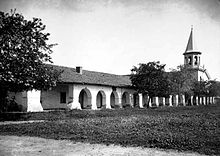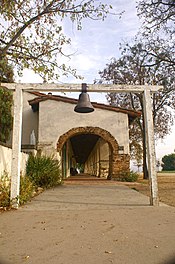Mission San Juan Bautista
Diocese of Monterey | |
| Current use | Parish Church |
|---|---|
| Reference no. |
|
| Website | |
| http://www.oldmissionsjb.org/ | |
Mission San Juan Bautista is a
Barracks for the soldiers, a nunnery, the
History



Following its creation in 1797, San Juan's population grew quickly. By 1803, there were 1,036 Native Americans living at the mission. Ranching and farming activity had moved apace, with 1,036 cattle, 4,600 sheep, 22 swine, 540 horses and 8 mules counted that year. At the same time, the harvest of wheat, barley and corn was estimated at 2,018 fanegas, each of about 220 pounds.

Father
The mission is situated adjacent to the
Although initially secularized in 1835, the church was reconsecrated by the Catholic Church in 1859, and continues to serve as a parish of the Diocese of Monterey. The mission includes a cemetery, with the remains of over 4,000 Native American converts and Europeans buried there.
The mission and its grounds were featured prominently in the 1958 Alfred Hitchcock film Vertigo. Associate producer Herbert Coleman's daughter Judy Lanini suggested the mission to Hitchcock as a filming location. A steeple, added sometime after the mission's original construction and secularization, had been demolished following a fire, so Hitchcock added a bell tower using scale models, matte paintings, and trick photography at the Paramount studio in Los Angeles. The tower does not resemble the original steeple. The tower's staircase was assembled inside a studio.
See also
- Spanish missions in California
- List of Spanish missions in California
- Rancho San Justo
- Teatro Campesino
- Buenaventura Class fleet oiler built during World War II.
References
- ^ Bennett 1897b, p. 153
- ^ a b c d Krell, p. 241
- ^ Ruscin, p. 121
- ^ Yenne, p. 132
- ^ Ruscin, p. 196
- ^ Forbes, p. 202
- ^ Ruscin, p. 195
- ^ a b c Krell, p. 315: as of December 31, 1832; information adapted from Engelhardt's Missions and Missionaries of California.
- ^ Robert Iacopi, Earthquake Country (Menlo Park:Lane Publishing, 2004, 1971).
Sources
- Bennett, John E. (February 1897b). "Should the California Missions Be Preserved? – Part II". Overland Monthly. XXIX (170): 150–161.
- Forbes, Alexander (1839). California: A History of Upper and Lower California. Cornhill, London: Smith, Elder and Co.
- Jones, Terry L.; Kathryn A. Klar, eds. (2007). California Prehistory: Colonization, Culture, and Complexity. Landham, MD: Altimira Press. ISBN 978-0759108721.
- Krell, Dorothy, ed. (1979). The California Missions: A Pictorial History. Menlo Park, CA: Sunset Publishing Corporation. ISBN 0376051728.
- Leffingwell, Randy (2005). California Missions and Presidios: The History & Beauty of the Spanish Missions. Stillwater, MN: Voyageur Press, Inc. ISBN 0896584925.
- Levy, Richard. (1978). William C. Sturtevant, and Robert F. Heizer (ed.). Handbook of North American Indians. Vol. 8 (California). Washington, DC: Smithsonian Institution. p. 486. ISBN 0160045789.
- Milliken, Randall (1995). A Time of Little Choice: The Disintegration of Tribal Culture in the San Francisco Bay Area 1769–1910. Menlo Park, CA: Ballena Press Publication. ISBN 0879191325.
- Paddison, Joshua, ed. (1999). A World Transformed: Firsthand Accounts of California Before the Gold Rush. Berkeley, CA: Heyday Books. ISBN 1890771139.
- Ruscin, Terry (1999). Mission Memoirs. San Diego, CA: Sunbelt Publications. ISBN 0932653308.
- Yenne, Bill (2004). The Missions of California. San Diego, CA: Thunder Bay Press. ISBN 1592233198.
External links
- Mission San Juan Bautista – official site
- Early photographs, sketches, land surveys of Mission San Juan Bautista, via Calisphere, California Digital Library
- Vertigo at IMDb
- Listing and photographs of church at the Historic American Buildings Survey
- Listing, drawings and photographs of mission at the Historic American Buildings Survey
- Another view of the Mission Facade, circa 1980s
- Howser, Huell (December 8, 2000). "California Missions (105)". California Missions. Chapman University Huell Howser Archive.
- U.S. Geological Survey Geographic Names Information System: Mission San Juan Bautista
- Mission San Juan Bautista Cemetery at Find a Grave

